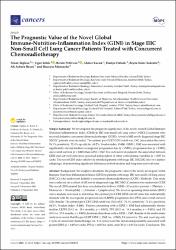| dc.contributor.author | Topkan, Erkan | |
| dc.contributor.author | Selek, Uğur | |
| dc.contributor.author | Pehlivan, Berrin | |
| dc.contributor.author | Kucuk, Ahmet | |
| dc.contributor.author | Öztürk, Duriye | |
| dc.contributor.author | Şirin Özdemir, Beyza | |
| dc.contributor.author | Besen, Ali Ayberk | |
| dc.contributor.author | Mertsoylu, Hüseyin | |
| dc.date.accessioned | 2023-10-17T13:17:17Z | |
| dc.date.available | 2023-10-17T13:17:17Z | |
| dc.date.issued | 2023 | en_US |
| dc.identifier.citation | Topkan, E., Selek, U., Pehlivan, B., Kucuk, A., Ozturk, D., Ozdemir, B. S., ... & Mertsoylu, H. (2023). The Prognostic Value of the Novel Global Immune-Nutrition-Inflammation Index (GINI) in Stage IIIC Non-Small Cell Lung Cancer Patients Treated with Concurrent Chemoradiotherapy. Cancers, 15(18), 4512. | en_US |
| dc.identifier.issn | 2072-6694 | |
| dc.identifier.uri | https://dx.doi.org/10.3390/cancers15184512. | |
| dc.identifier.uri | https://hdl.handle.net/20.500.12933/1650 | |
| dc.description.abstract | Background: We sought to determine the prognostic value of the newly developed Global Immune-Nutrition-Inflammation Index (GINI) in patients with stage IIIC non-small cell lung cancer (NSCLC) who underwent definitive concurrent chemoradiotherapy (CCRT).
Methods: This study was conducted on a cohort of 802 newly diagnosed stage IIIC NSCLC patients who underwent CCRT. The novel GINI created first here was defined as follows: GINI = [C-reactive protein × Platelets × Monocytes × Neutrophils] ÷ [Albumin × Lymphocytes]. The receiver operating characteristic (ROC) curve analysis was used to determine the optimal pre-CCRT GINI cut-off value that substantially interacts with the locoregional progression-free (LRPFS), progression-free (PFS), and overall survival (OS).
Results: The optimal pre-CCRT GINI cutoff was 1562 (AUC: 76.1%; sensitivity: 72.4%; specificity: 68.2%; Youden index: 0.406). Patients presenting with a GINI ≥ 1562 had substantially shorter median LRPFS (13.3 vs. 18.4 months; p < 0.001), PFS (10.2 vs. 14.3 months; p < 0.001), and OS (19.1 vs. 37.8 months; p < 0.001) durations than those with a GINI < 1562. Results of the multivariate analysis revealed that the pre-CCRT GINI ≥ 1562 (vs. <1562), T4 tumor (vs. T3), and receiving only 1 cycle of concurrent chemotherapy (vs. 2-3 cycles) were the factors independently associated with poorer LRPS (p < 0.05 for each), PFS (p < 0.05 for each), and OS (p < 0.05 for each).
Conclusion: The newly developed GINI index efficiently divided the stage IIIC NSCLSC patients into two subgroups with substantially different median and long-term survival outcomes. | en_US |
| dc.language.iso | eng | en_US |
| dc.publisher | Switzerland | en_US |
| dc.relation.isversionof | 10.3390/cancers15184512. | en_US |
| dc.rights | info:eu-repo/semantics/openAccess | en_US |
| dc.subject | Global Immune-Nutrition-Inflammation Index | en_US |
| dc.subject | Biological Marker | en_US |
| dc.subject | Chemoradiotherapy | en_US |
| dc.subject | Non-Small Cell Lung Cancer | en_US |
| dc.subject | Prognosis | en_US |
| dc.subject | Survival | en_US |
| dc.title | The prognostic Vvalue of the novel global Immune-nutrition-inflammation index (GINI) in stage IIIC non-small cell lung cancer patients treated with concurrent chemoradiotherapy | en_US |
| dc.type | article | en_US |
| dc.authorid | 0000-0002-3265-2797 | en_US |
| dc.department | AFSÜ, Tıp Fakültesi, Dahili Tıp Bilimleri Bölümü, Radyasyon Onkolojisi Ana Bilim Dalı | en_US |
| dc.contributor.institutionauthor | Öztürk, Duriye | |
| dc.identifier.volume | 15 | en_US |
| dc.identifier.issue | 18 | en_US |
| dc.relation.journal | Cancers | en_US |
| dc.relation.publicationcategory | Makale - Uluslararası Hakemli Dergi - Kurum Öğretim Elemanı | en_US |
















